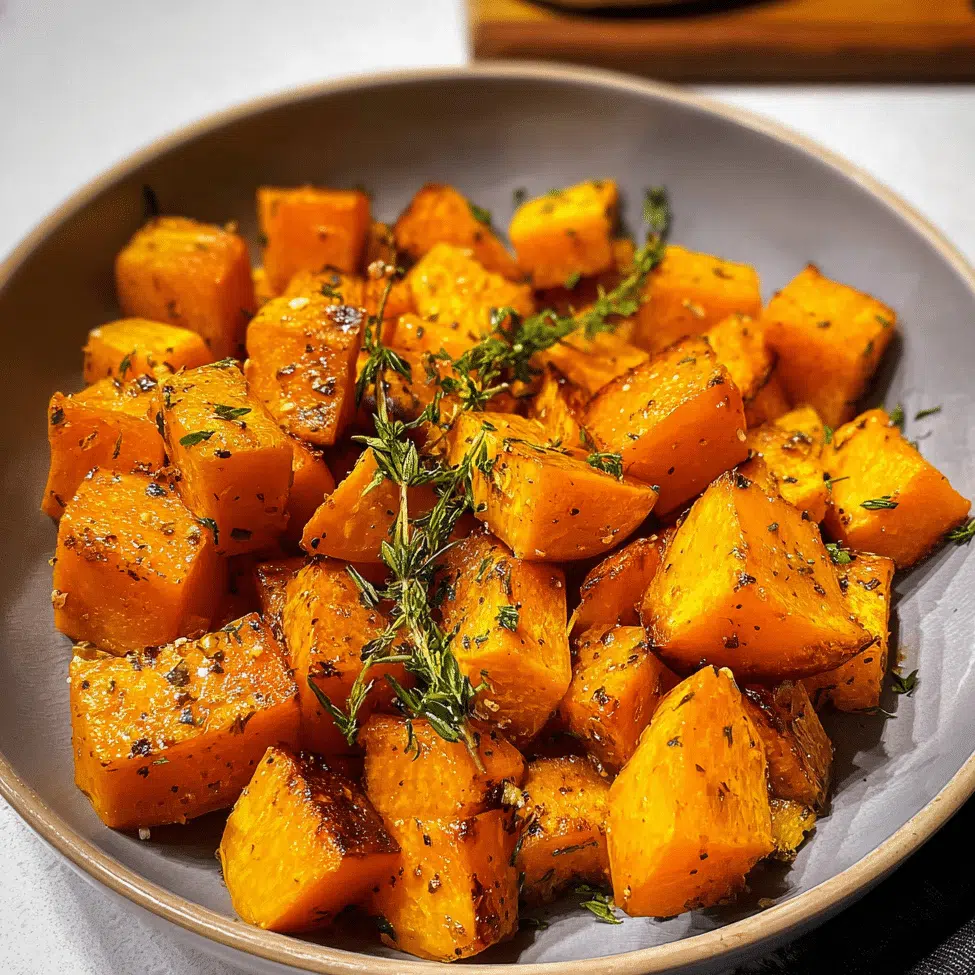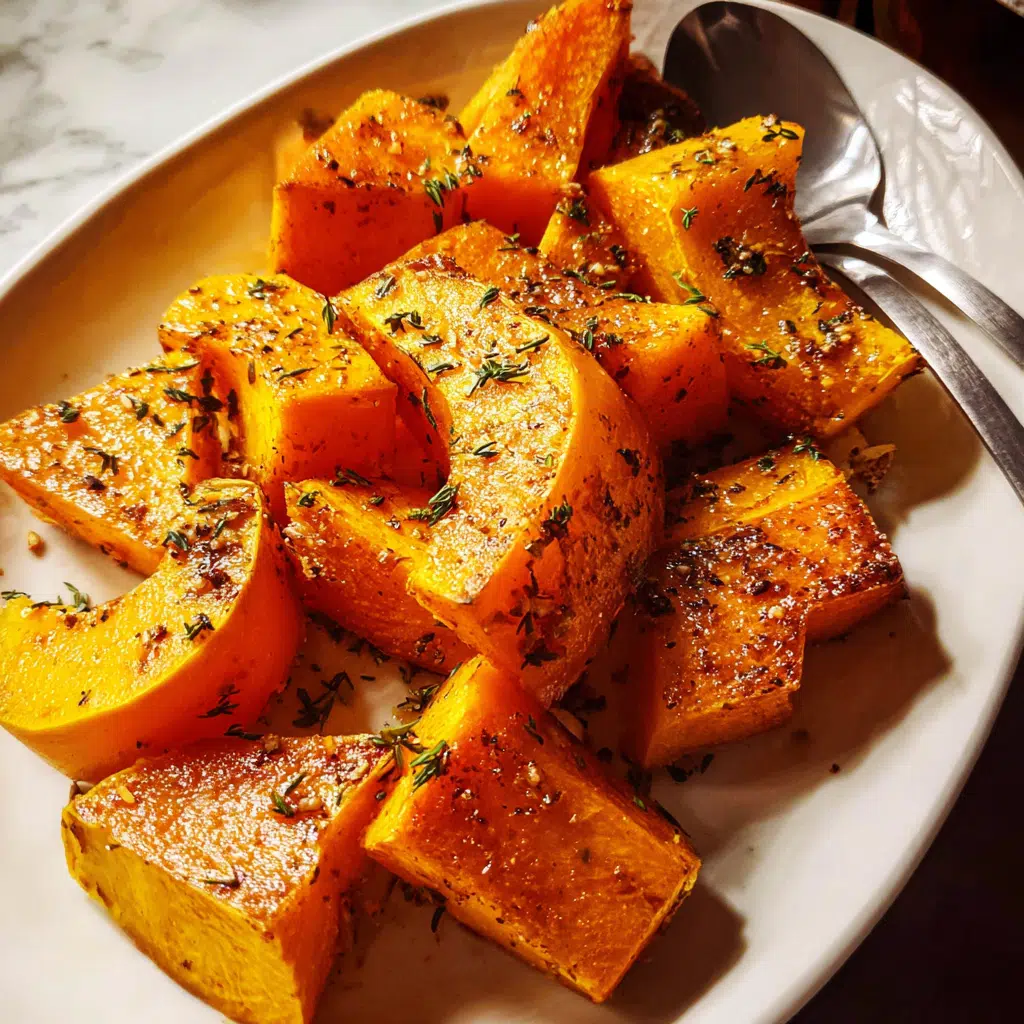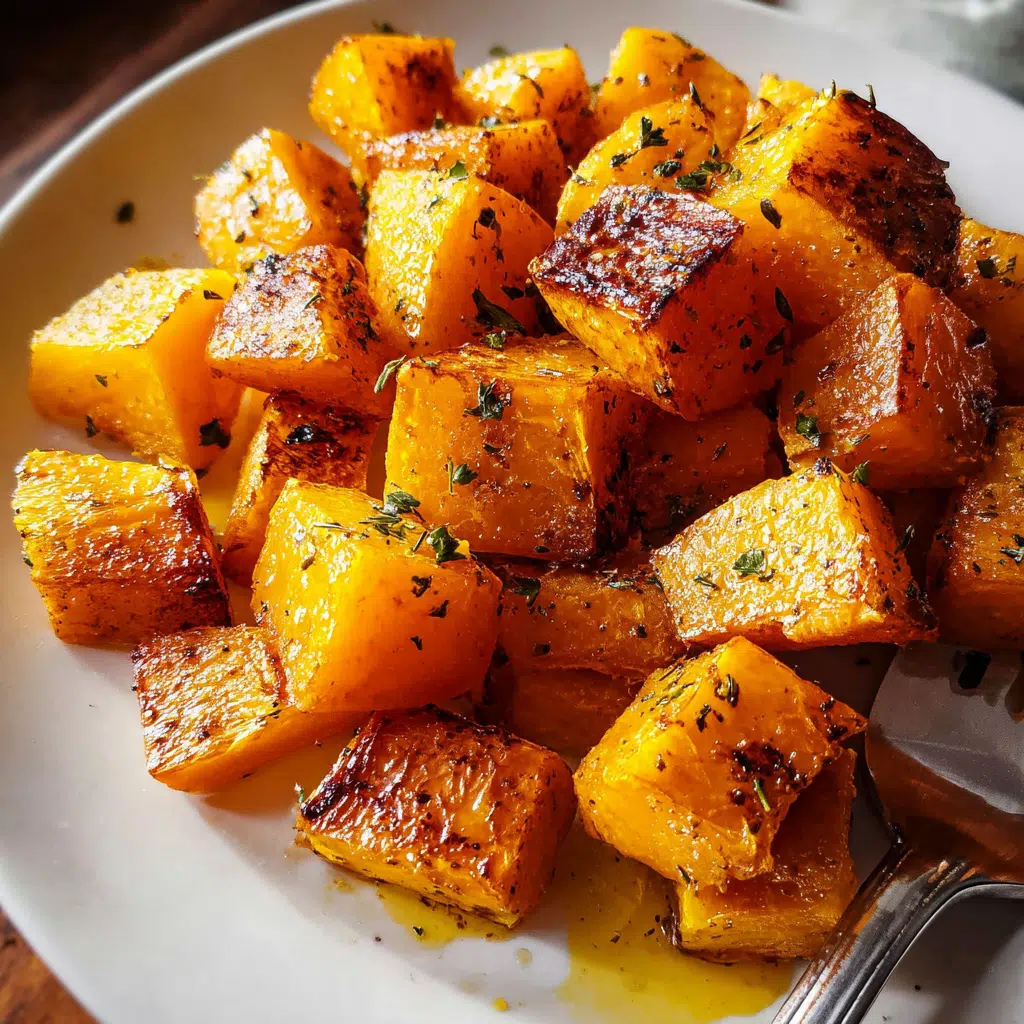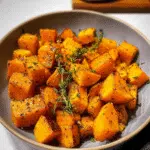Roasted butternut squash struggles are real – mushy texture, bland flavor, and uneven cooking can turn this nutritious vegetable into a disappointing side dish. But what if I told you that perfectly caramelized, tender roasted butternut squash with golden edges and sweet, nutty flavors is just one recipe away?
Hi there! I’m Lisa, the heart and soul behind Recipesrealm, and after years of perfecting this roasted butternut squash technique, I’ve discovered the secret to transforming this humble winter vegetable into a show-stopping centerpiece. This isn’t just another vegetable recipe – it’s a game-changer that will make you fall in love with butternut squash all over again.
As someone who’s spent countless hours in the kitchen experimenting with different roasting methods, temperatures, and seasoning combinations, I can confidently say this roasted butternut squash recipe delivers every single time. The key lies in proper preparation, optimal roasting temperature, and the perfect balance of seasonings that enhance the squash’s natural sweetness.
In this comprehensive guide, you’ll discover foolproof techniques for selecting the perfect butternut squash, preparation shortcuts that save time, step-by-step roasting instructions, and creative flavor variations that will keep this recipe exciting meal after meal. Plus, I’ll share professional tips for achieving that coveted caramelized exterior while maintaining a creamy, tender interior.

Why This Roasted Butternut Squash Recipe Works
This roasted butternut squash method has become my go-to approach because it consistently delivers restaurant-quality results with minimal effort. The technique focuses on three crucial elements: proper preparation, optimal heat distribution, and strategic seasoning that enhances rather than masks the squash’s natural flavors.
Here’s what makes this roasted butternut squash recipe stand out:
- Uses high-heat roasting for perfect caramelization – The 425°F temperature creates beautiful golden edges while keeping the interior creamy
- Ready in just 45 minutes with 10 minutes prep time – Perfect for busy weeknights when you need a nutritious side dish quickly
- Versatile enough for any season or occasion – Works equally well for casual family dinners or elegant holiday gatherings
- Naturally gluten-free and vegan-friendly – Accommodates various dietary preferences without compromising flavor
- Packed with nutrients including vitamin A, fiber, and potassium – Delivers exceptional nutritional value alongside incredible taste
- Cost-effective using affordable, seasonal ingredients – One large butternut squash feeds 6-8 people for under $3
The magic happens during the roasting process when the squash’s natural sugars concentrate and caramelize, creating complex flavors that range from sweet and nutty to slightly savory. This transformation occurs because the high heat breaks down the squash’s cellular structure while evaporating excess moisture, intensifying every bite.
Choosing the Right Roasted Butternut Squash
Selecting the perfect butternut squash is crucial for achieving optimal results in your roasted butternut squash dish. The quality of your squash directly impacts the final texture, flavor, and overall success of the recipe.
Best Squash Selection for This Roasted Butternut Squash Recipe
When shopping for butternut squash, look for specimens that feel heavy for their size, indicating high moisture content and dense flesh. The ideal butternut squash should have a smooth, matte skin without glossy patches, which can indicate immaturity. The color should be uniformly tan or beige, avoiding any green tinges that suggest the squash was harvested too early.
Size matters when choosing butternut squash for roasting. Medium to large squashes (2-3 pounds) offer the best flesh-to-seed ratio and more consistent cooking. Smaller squashes tend to have proportionally more seeds and less flesh, while extremely large ones may have developed woody textures or excessive stringiness.
Buying Tips for Perfect Roasted Butternut Squash
Visit your local farmer’s market or grocery store during peak season (September through February) when butternut squash is at its best. Ask produce managers when their latest shipment arrived – fresher squashes roast more evenly and develop better caramelization.
Check for any soft spots, cracks, or blemishes on the skin, as these can indicate internal decay or affect cooking times. The stem should be dry and woody, not green or moist, which suggests recent harvest and proper curing.
Substitutions for Your Roasted Butternut Squash Recipe
While butternut squash is ideal for this recipe, you can substitute other winter squashes with similar results. Honeynut squash works beautifully but requires shorter cooking times due to its smaller size. Acorn squash offers a slightly nuttier flavor profile, while delicata squash provides a creamier texture with edible skin.
For those avoiding squash altogether, sweet potatoes or carrots can be roasted using the same technique, though cooking times may vary. Root vegetables like parsnips or turnips also work well, offering different flavor profiles while maintaining the caramelized exterior and tender interior.
Ingredients & Prep for Roasted Butternut Squash
Proper ingredient selection and preparation are fundamental to creating exceptional roasted butternut squash. Each component plays a specific role in developing the complex flavors and textures that make this dish memorable.
Essential Prep for Perfect Roasted Butternut Squash
Begin by gathering your ingredients and tools before starting preparation. You’ll need a sharp chef’s knife, sturdy cutting board, vegetable peeler, large spoon for scooping seeds, and two rimmed baking sheets for optimal spacing.
Main Ingredients:
- 1 large butternut squash (2-3 pounds)
- 3 tablespoons extra-virgin olive oil
- 1 teaspoon kosher salt
- 1/2 teaspoon freshly ground black pepper
- 1/2 teaspoon garlic powder
- 1/4 teaspoon smoked paprika
Optional Flavor Enhancers:
- 2 tablespoons fresh thyme leaves
- 1 tablespoon maple syrup
- 1/4 teaspoon cayenne pepper
- 2 tablespoons toasted pumpkin seeds
Roasted Butternut Squash Seasoning and Marinades
The beauty of roasted butternut squash lies in its ability to absorb and complement various seasonings. The basic olive oil, salt, and pepper combination allows the squash’s natural sweetness to shine while adding depth through proper seasoning.
For enhanced flavor development, consider these marinade options:
Herb-Infused Marinade:
- 1/4 cup olive oil
- 2 tablespoons chopped fresh rosemary
- 1 tablespoon minced garlic
- 1 teaspoon dried oregano
Sweet and Spicy Blend:
- 3 tablespoons olive oil
- 1 tablespoon honey
- 1 teaspoon ground cinnamon
- 1/2 teaspoon chili powder
- 1/4 teaspoon nutmeg
Allow the seasoned squash to rest for 15-20 minutes before roasting. This brief marinating period helps the seasonings penetrate the surface and creates more uniform flavor distribution throughout the roasted butternut squash.
Pantry Staples for Roasted Butternut Squash Success
Keep these essential pantry items on hand for consistent roasted butternut squash results:
Oils and Fats:
- Extra-virgin olive oil (primary choice for flavor)
- Avocado oil (high smoke point alternative)
- Melted butter (for rich, indulgent finish)
Seasonings and Spices:
- Kosher salt (for even distribution)
- Freshly ground black pepper
- Garlic powder or granules
- Smoked paprika
- Ground cinnamon
- Fresh or dried herbs (thyme, rosemary, sage)
Acids for Balance:
- Fresh lemon juice
- Balsamic vinegar
- Apple cider vinegar
These ingredients work synergistically to enhance the roasted butternut squash’s natural flavors while adding complexity and depth to the final dish.
Step-by-Step Roasted Butternut Squash Cooking Instructions
Following proper technique ensures your roasted butternut squash develops the perfect balance of caramelized exterior and creamy interior. Each step builds upon the previous one, creating layers of flavor and texture.
Pre-Cooking Prep for Roasted Butternut Squash
Start by preheating your oven to 425°F (220°C) and positioning racks in the center and upper third of the oven. This temperature provides the ideal balance between caramelization and even cooking for your roasted butternut squash.
Wash the butternut squash thoroughly under cold water, scrubbing the skin to remove any dirt or residue. Pat completely dry with paper towels – excess moisture can interfere with proper browning during roasting.
Using a sharp chef’s knife, carefully cut off both ends of the squash, creating stable surfaces. Stand the squash upright and use a vegetable peeler to remove the skin in long strips from top to bottom. Work slowly and maintain control, as butternut squash can be slippery.
Cut the squash in half where the bulbous bottom meets the cylindrical neck. Slice the neck portion into 1-inch thick rounds, then cut each round into 1-inch cubes. For the bottom section, cut in half lengthwise and scoop out seeds with a large spoon. Cut this section into similar-sized cubes for even cooking.
Cooking Method for Perfect Roasted Butternut Squash
Place the cubed butternut squash in a large mixing bowl and drizzle with olive oil. Use your hands to toss the pieces, ensuring every surface is lightly coated with oil. This coating is crucial for achieving the characteristic caramelized exterior.
Season the oiled squash with salt, pepper, and your chosen spices. Toss again to distribute seasonings evenly. The key to exceptional roasted butternut squash is ensuring uniform seasoning distribution – each piece should have a light, even coating.
Line two large rimmed baking sheets with parchment paper for easy cleanup and to prevent sticking. Arrange the seasoned squash pieces in a single layer, ensuring pieces don’t overlap or crowd together. Overcrowding leads to steaming rather than roasting, preventing proper caramelization.
Doneness Check for Roasted Butternut Squash
Place the prepared roasted butternut squash in the preheated oven and roast for 25-30 minutes. The exact timing depends on the size of your pieces and your oven’s characteristics. Look for golden-brown edges and slight caramelization as indicators of proper cooking progress.
Test doneness by inserting a fork into the largest pieces – it should slide in easily with minimal resistance. The exterior should be golden brown with some darker caramelized spots, while the interior remains tender and creamy.
For enhanced caramelization, switch to broiler setting for the final 2-3 minutes, watching carefully to prevent burning. This final step intensifies the roasted butternut squash’s flavor and creates beautiful color contrast.
Resting Your Roasted Butternut Squash
Allow the roasted butternut squash to rest on the baking sheets for 5 minutes after removing from the oven. This brief resting period allows the flavors to settle and prevents the pieces from falling apart when transferred to serving dishes.
During this resting time, the residual heat continues cooking the squash slightly while the exterior firms up, making handling easier. The caramelized surfaces also develop additional complexity during this crucial final step.
Pro Tips for Perfect Roasted Butternut Squash
These professional techniques elevate your roasted butternut squash from good to extraordinary. After years of refining this recipe, these tips consistently produce restaurant-quality results.
Avoiding Common Roasted Butternut Squash Mistakes
The most frequent mistake when preparing roasted butternut squash is cutting pieces too small or too large. Aim for uniform 1-inch cubes – smaller pieces burn before the interior cooks properly, while larger pieces remain undercooked when the exterior appears done.
Never skip the oil coating step. Each piece needs adequate fat to develop proper caramelization and prevent sticking. However, too much oil creates soggy, greasy results rather than the desired crispy exterior.
Temperature consistency is crucial for perfect roasted butternut squash. Avoid opening the oven door frequently, as this causes temperature fluctuations that interfere with even cooking and caramelization development.
Tool Recommendations for Roasted Butternut Squash Success
Invest in quality tools for consistent roasted butternut squash results:
Essential Equipment:
- Sharp 8-10 inch chef’s knife for safe, efficient cutting
- Sturdy cutting board with non-slip base
- Large mixing bowls for tossing and seasoning
- Heavy-duty rimmed baking sheets that won’t warp
- Parchment paper or silicone baking mats
Helpful Additions:
- Y-shaped vegetable peeler for easier skin removal
- Large spoon or ice cream scoop for seed removal
- Kitchen scale for consistent piece sizing
- Timer with multiple alarms for perfect timing
Storage & Reheating Your Roasted Butternut Squash
Properly stored roasted butternut squash maintains quality for up to one week in the refrigerator. Transfer cooled squash to airtight containers, separating layers with parchment paper to prevent sticking.
For longer storage, freeze roasted butternut squash in single-serving portions for up to three months. Spread pieces on baking sheets and freeze until solid before transferring to freezer bags – this prevents clumping and makes portion control easier.
Reheat roasted butternut squash in a 375°F oven for 8-10 minutes until heated through. Avoid microwaving, which creates mushy textures and eliminates the desirable caramelized exterior you worked to achieve.

Flavor Variations for Roasted Butternut Squash
Experimenting with different flavor profiles keeps your roasted butternut squash exciting and prevents meal monotony. These variations build on the basic technique while introducing new taste dimensions.
Spicy Roasted Butternut Squash Twist
Transform your roasted butternut squash with heat and complexity by incorporating warming spices. Add 1/2 teaspoon chipotle powder, 1/4 teaspoon cayenne pepper, and 1 teaspoon ground cumin to the basic seasoning mix.
For Mediterranean-inspired heat, combine 1 teaspoon red pepper flakes, 2 tablespoons za’atar seasoning, and a squeeze of fresh lemon juice before roasting. This combination creates layers of heat balanced by herbaceous and citrus notes.
Indian-spiced variations work beautifully with roasted butternut squash. Blend 1 teaspoon garam masala, 1/2 teaspoon turmeric, 1/4 teaspoon ground ginger, and a pinch of cardamom for an aromatic, warming dish that pairs perfectly with rice or quinoa.
Healthy Roasted Butternut Squash Options
Maintain the nutritious profile of roasted butternut squash while exploring different preparation methods. For oil-free cooking, use vegetable broth or coconut milk for moisture, though this alters the texture slightly by reducing caramelization.
Boost nutritional content by tossing finished roasted butternut squash with toasted seeds and nuts. Pumpkin seeds, sunflower seeds, and chopped walnuts add protein, healthy fats, and textural contrast while complementing the squash’s natural flavors.
Create a superfood version by combining roasted butternut squash with other colorful vegetables like Brussels sprouts, red onions, and bell peppers. This rainbow approach maximizes nutrient density while creating visual appeal.
Global Flavors for Roasted Butternut Squash
Explore international cuisine influences to transform your roasted butternut squash into worldly dishes:
Asian-Inspired Roasted Butternut Squash:
- 2 tablespoons sesame oil
- 1 tablespoon rice vinegar
- 1 teaspoon grated fresh ginger
- 1 teaspoon toasted sesame seeds
- 1 tablespoon chopped scallions
Mexican-Style Roasted Butternut Squash:
- 1 teaspoon chili powder
- 1/2 teaspoon ground cumin
- 1/4 teaspoon smoked paprika
- 1 tablespoon lime juice
- 2 tablespoons chopped cilantro
Italian-Herb Roasted Butternut Squash:
- 2 tablespoons fresh rosemary
- 1 tablespoon fresh sage
- 2 cloves minced garlic
- 1/4 cup grated Parmesan cheese
- 1 tablespoon balsamic glaze
| Flavor Profile | Key Ingredients | Cooking Time | Best Served With |
|---|---|---|---|
| Classic Herb | Thyme, rosemary, sage | 25-30 minutes | Roasted chicken, turkey |
| Sweet & Spicy | Maple syrup, cayenne, cinnamon | 25-30 minutes | Pork tenderloin, quinoa |
| Mediterranean | Oregano, lemon, feta cheese | 25-30 minutes | Grilled fish, couscous |
| Asian Fusion | Ginger, sesame oil, rice vinegar | 25-30 minutes | Teriyaki salmon, brown rice |
| Mexican Inspired | Cumin, chili powder, lime | 25-30 minutes | Black beans, cilantro rice |
| Indian Spiced | Garam masala, turmeric, ginger | 30-35 minutes | Basmati rice, naan bread |
Serving Suggestions for Roasted Butternut Squash
The versatility of roasted butternut squash makes it an ideal accompaniment to numerous dishes across various cuisines and dietary preferences. Strategic pairing enhances both the squash and accompanying dishes.
Perfect Pairings with Roasted Butternut Squash
Roasted butternut squash complements rich, savory proteins beautifully. The natural sweetness balances the umami flavors in roasted chicken, turkey, or beef. For vegetarian meals, pair with protein-rich legumes like black beans, lentils, or chickpeas.
Grain-based sides create satisfying, complete meals when served alongside roasted butternut squash. Wild rice, quinoa, and farro provide textural contrast while absorbing the squash’s caramelized flavors. These combinations work especially well for meal prep and batch cooking.
Fresh, acidic elements brighten the rich, sweet flavors of roasted butternut squash. Consider serving with:
- Arugula salad with lemon vinaigrette
- Pomegranate seeds and fresh herbs
- Cranberry and walnut mixtures
- Pickled onions or cucumbers
Beverage Pairings for Roasted Butternut Squash
Non-alcoholic beverages that complement roasted butternut squash include sparkling water with citrus, herbal teas like chamomile or ginger, and fresh fruit juices such as apple or cranberry. These drinks cleanse the palate without overwhelming the squash’s delicate flavors.
For special occasions, consider sparkling cider or kombucha varieties that offer effervescence and subtle acidity to balance the dish’s richness.

FAQs About Roasted Butternut Squash
Can I use frozen butternut squash for this roasted butternut squash recipe?
While fresh butternut squash produces superior results, frozen can work in a pinch. Thaw completely and pat dry thoroughly before seasoning and roasting. Expect slightly longer cooking times and less caramelization due to higher moisture content in frozen varieties.
Frozen butternut squash often has softer texture and may not achieve the same level of caramelized exterior as fresh. However, it’s still delicious and convenient for busy weeknight meals when fresh squash isn’t available.
How do I fix overcooked roasted butternut squash?
Overcooked roasted butternut squash becomes mushy and loses its appealing texture. While you cannot reverse overcooking, you can repurpose it creatively. Mash overcooked squash into soups, purees, or use as baby food. It also works well blended into smoothies or incorporated into baked goods like muffins or bread.
To prevent overcooking future batches, check doneness 5 minutes earlier than recipe suggests and adjust timing based on your oven’s characteristics and piece sizes.
Is this roasted butternut squash recipe suitable for special diets?
This basic roasted butternut squash recipe is naturally suitable for numerous dietary restrictions. It’s vegan, vegetarian, gluten-free, dairy-free, and fits into paleo and whole food plant-based eating patterns.
For ketogenic diets, butternut squash is relatively high in carbohydrates (about 16g per cup), so portion control is important. Those following low-carb diets might prefer substituting with lower-carb vegetables like cauliflower or zucchini.
How long does roasted butternut squash keep?
Properly stored roasted butternut squash maintains quality for 5-7 days in the refrigerator when stored in airtight containers. For optimal freshness, cool completely before refrigerating and separate into meal-sized portions.
Frozen roasted butternut squash keeps for 2-3 months. While texture changes slightly after freezing, it remains perfectly suitable for soups, stews, and pureed applications.
Can I prepare roasted butternut squash ahead of time?
Absolutely! Roasted butternut squash is excellent for meal prep and advance preparation. You can cube and season the raw squash up to 2 days ahead, storing covered in the refrigerator until ready to roast.
Fully cooked roasted butternut squash can be prepared 2-3 days in advance and reheated before serving. This makes it ideal for holiday meal planning and busy weeknight dinners when time is limited.
What’s the best way to cut butternut squash safely?
Safety is paramount when preparing butternut squash due to its tough exterior and rounded shape. Always use a sharp knife – dull knives require more pressure and are more likely to slip.
Create stable cutting surfaces by trimming both ends first, then stand the squash upright for peeling. Work slowly and maintain control throughout the cutting process. Consider purchasing pre-cut butternut squash if mobility or knife skills are concerns.
Conclusion
This roasted butternut squash recipe represents the perfect balance of simplicity and sophistication, transforming a humble winter vegetable into a show-stopping side dish that elevates any meal. The combination of proper technique, optimal seasoning, and high-heat roasting creates the ideal contrast between caramelized exterior and creamy interior that makes every bite memorable.
Throughout this comprehensive guide, we’ve explored every aspect of creating perfect roasted butternut squash – from selecting the ideal squash and mastering preparation techniques to exploring creative flavor variations and professional tips that ensure consistent results. The versatility of this recipe means you’ll never run out of ways to enjoy this nutritious, delicious vegetable.
Remember that the key to exceptional roasted butternut squash lies in attention to detail: uniform cutting for even cooking, proper seasoning distribution, adequate spacing on baking sheets, and monitoring for that perfect golden-brown caramelization. These fundamentals, combined with the creative variations we’ve discussed, will keep this recipe exciting meal after meal.
As you embark on your roasted butternut squash journey, don’t be afraid to experiment with different seasonings, serving suggestions, and preparation methods. Each variation teaches you something new about this wonderful vegetable and helps you develop your own signature style.
The nutritional benefits of butternut squash – including high levels of vitamin A, fiber, and potassium – make this recipe as healthful as it is delicious. It’s satisfying to know that something so tasty is also nourishing your body and supporting your wellness goals.
Fire up your oven and try this roasted butternut squash recipe tonight! Your family and friends will be impressed by the restaurant-quality results you achieve at home. Once you master this technique, roasted butternut squash will become a regular feature on your dining table, bringing warmth, comfort, and exceptional flavor to countless meals.
Join thousands of home cooks who’ve discovered the joy of perfectly roasted butternut squash! Try our Sweet and Easy Maple Glazed Carrots Recipe next for another warming winter dish that showcases seasonal vegetables.
If you loved this recipe, don’t forget to share it with your friends or save it to try later! I’d be thrilled to see your personal touch—share your photos on Pinterest
Print
Healthy Easy Roasted Butternut Squash Recipe
- Total Time: 35–40 minutes
- Yield: 4 servings 1x
Description
Simple and healthy roasted butternut squash with olive oil, salt, and pepper. Perfect as a nutritious side dish for any meal or as a warm salad ingredient.
Ingredients
1 medium butternut squash, peeled, seeded, and cubed
2 tbsp olive oil
1/2 tsp salt
1/4 tsp black pepper
Optional: 1/2 tsp cinnamon, 1 tsp maple syrup, or fresh herbs like rosemary or thyme
Instructions
1. Preheat oven to 400°F (200°C) and line a baking sheet with parchment paper.
2. In a large bowl, toss butternut squash cubes with olive oil, salt, pepper, and optional spices or herbs.
3. Spread evenly on the prepared baking sheet.
4. Roast for 25–30 minutes, tossing halfway through, until squash is tender and lightly browned.
5. Remove from oven and serve warm as a side dish or add to salads.
Notes
Use uniform-sized cubes for even roasting.
For extra sweetness, drizzle lightly with maple syrup before roasting.
Can be made ahead and reheated in the oven.
- Prep Time: 10 minutes
- Cook Time: 25–30 minutes
- Category: Side Dish, Healthy
- Method: Oven-Roasted
- Cuisine: American
Nutrition
- Serving Size: 1 cup
- Calories: 90
- Sugar: 3g
- Sodium: 120mg
- Fat: 5g
- Saturated Fat: 0.7g
- Unsaturated Fat: 4g
- Trans Fat: 0g
- Carbohydrates: 12g
- Fiber: 3g
- Protein: 1g
- Cholesterol: 0mg
Keywords: Roasted Butternut Squash, Healthy Side Dish, Easy Vegetables, Oven-Roasted Squash

